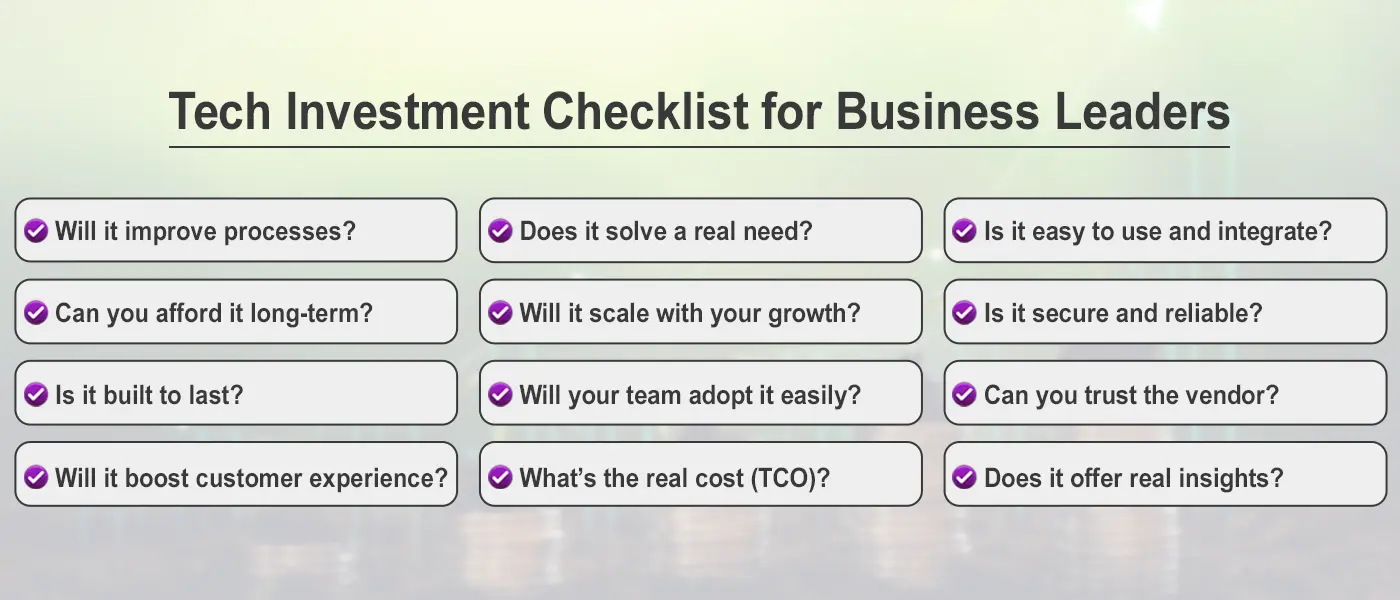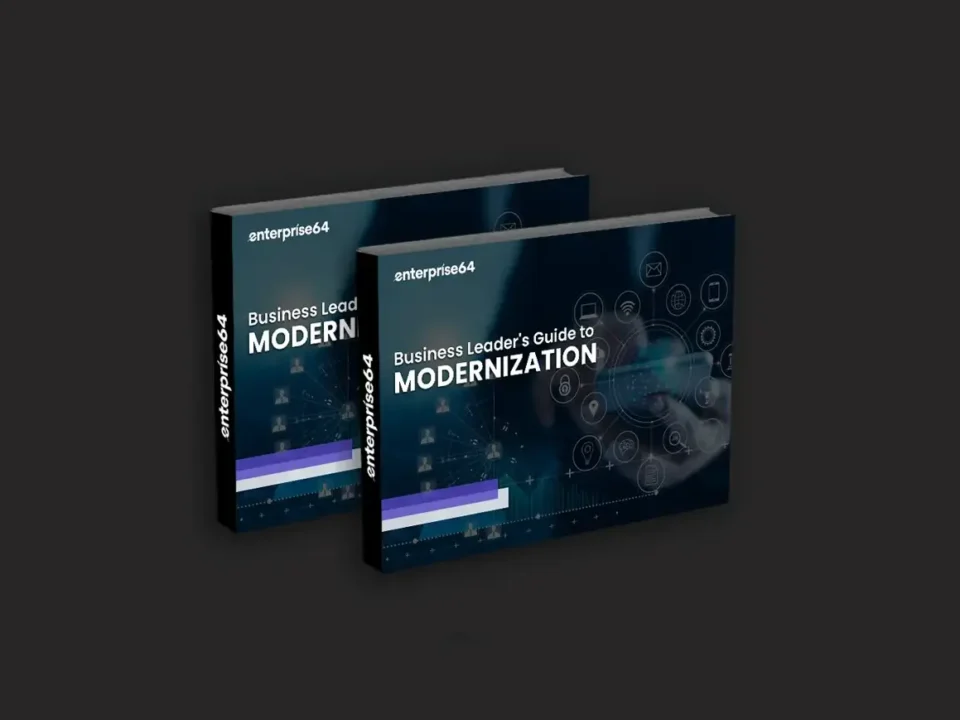Global IT spending is projected to exceed $5.6 trillion this year, a 10%+ increase from 2024, as companies are prioritizing tech investments with the highest ROI.
But before jumping into new tools and technology solutions, leaders must ask critical questions to ensure their choices drive efficiency, growth, and long-term value.
How will this technology improve your existing systems and processes?
Any investment you’re about to make should be able to enhance your existing processes. For example, implementing a cloud-based ERP system can streamline inventory management, accounting, and human resources by centralizing data and automating repetitive tasks.
Similarly, integrating AI-powered analytics tools can help you make faster, more informed decisions by identifying patterns across your operations. The entire point is that the new technology must simplify complexity, increase efficiency, and help your team innovate.
Does this solution address your core business needs?
Not every technology investment is the missing piece of the puzzle for your business. The tech solution you wish to incorporate must justifiably complement your needs or at least try to solve a problem.
For example, if your sales team struggles with managing leads and following up on time, investing in a CRM like Salesforce can help automate follow-ups, track customer interactions, and improve overall conversion rates. The investment must directly address a pain point rather than adding unnecessary complexity.
Understanding whether your tech investments align with your business needs keeps you from falling into the rabbit hole of purchasing unwanted suites that do not actually help your processes or operations.
Is it easy to use and integrate into your workflows?
If the new tech stack is capable of fulfilling your goals, it still needs to be usable. In short, the technologies must take the right time to fully integrate with your company’s processes and workflows.
Adopting a team collaboration tool like Slack or Microsoft Teams might only take a few days to roll out across departments, with minimal training required. On the other hand, implementing a new customer data platform (CDP) to combine marketing and sales data under a single dashboard might require weeks of backend integration, custom development, and employee onboarding.
Although the long-term value can be significant, offering better personalization, real-time customer insights, and more. However, the upfront effort must be carefully weighed against the expected ROI.
Can this technology fit within your budget?
Business leaders, especially in the mid-market segment, are mindful of their budget, particularly when investing in new tech solutions. Given that tech budgets will only increase, adopting technologies that fit within your budget has become more important than ever.
However, not only the cost of adoption but also implementation and ongoing maintenance costs must be considered. For example, while a custom-built analytics platform might offer tailor-made insights, it could also demand a substantial upfront investment, ongoing developer support, and expensive infrastructure.
Comparatively, a SaaS-based analytics tool like Power BI can offer similar value at a fraction of the cost with predictable subscription pricing and minimal setup. Choosing wisely ensures long-term sustainability without straining your resources.
Will it scale as your business grows?
The purpose of adding new technologies is not only to streamline your processes and enhance operational efficiency, but also to scale alongside your business. Otherwise, they risk becoming useless and adding overhead in a few years.
Suppose your team uses Asana, Monday.com, or any other project management tool. In that case, it should allow you to easily add new team members, create complex workflows, and integrate with tools like Slack or Google Drive as your operations expand. A scalable tool like this ensures you’re not forced to migrate to a new platform whenever your team size or operational complexity fluctuates.
Any new technologies you add must have a defined plan to accommodate new resource additions, features, and integrations. You must also clearly understand how these advancements align with your growth objectives.
Does it offer the reliability and security your operations require?
The new technologies must offer reliability and security for your digital transformation initiatives. This is a non-negotiable aspect that can potentially compromise your entire tech stack and your company’s data.
For example, migrating your infrastructure to a cloud provider like AWS or Microsoft Azure will ensure high availability, regular security updates, and compliance with the industry’s data protection standards. Compared to hosting on unreliable platforms with limited security protocols, a reliable cloud provider minimizes downtime, protects against data breaches, and allows your business to scale.
As a business leader or technical executive, you must conduct regular vulnerability assessments, prepare incident response plans, and manage user access controls.
Is this a long-term solution or just a temporary fix?
Although new technologies are often incorporated to serve urgent needs and to do something in trend, it is important to ask: Will it last, or is it just a short-term fix?
While some startups offer fancy AI tools with niche use cases, choosing a platform like OpenAI or Google Cloud’s AI services is more viable as it provides greater assurance.
These companies consistently invest in updates, support, and ecosystem growth, alleviating the risk of getting your hands on a flashy tool that the market and users will potentially forget about in a year or two.
Besides ensuring the technologies won’t go down the drain and become obsolete, you must also ascertain that they are easy to use and maintain.
How easy will it be for your team to adopt and use this technology?
Even the most promising technology can fail if your team struggles to adopt it. Solutions that come with steep learning curves or lack onboarding support can lead to underuse, let alone delivering value-added services or capturing a loyal customer base.
For example, switching to a sophisticated enterprise data lake without involving your data team from the onset can create friction and resistance. On the other hand, adopting a marketing automation tool like Mailchimp, which offers built-in tutorials and intuitive UX, allows non-technical users to begin executing campaigns quickly and effectively.
You must factor in your team’s readiness, learning curve, and whether your workforce can help drive adoption.
Handpicked content: Top 9 Business Process Automation Trends for Modern Teams
Can you trust the vendor’s reputation and support ecosystem?
Reliability doesn’t stop at the product purchase; it extends to the company behind it. A technology partner’s stability, reputation, and support capabilities are just as important as the product’s features.
For instance, choosing an email delivery platform backed by a stable company like Twilio (SendGrid) ensures you’ll get regular updates, consistent support, and strong community resources. In contrast, using a lesser-known tool without active development or customer support might leave you stranded during a system failure or feature bug.
Determine if the vendor offers ongoing support and updates and what current users say about its market reputation.
Will this technology enhance your customer experience?
Sometimes, the best investments are the ones that customers notice, even indirectly. If a new platform helps your teams respond faster, easily personalize communication, or resolve issues quickly, that’s the customer experience you want to deliver and experience yourself.
For example, deploying a chatbot powered by OpenAI’s API can cut response times dramatically, enabling customers to get instant answers to FAQs even after hours. Or adopting a centralized helpdesk tool like Zendesk can streamline support across channels, reducing ticket resolution time.
Your investments should enhance how your customers experience your services and offerings, not just how your internal team works.
Have you evaluated the total cost of ownership (TCO)?
A low upfront cost can sometimes secretly lead to high long-term expenses. Beyond the initial price tag, look at the total cost of ownership: implementation, training, integrations, updates, and potential downtime.
For example, an open-source CMS like WordPress might be “free.” Still, when you add the cost of plugins, hosting, maintenance, and developer hours for customization, it could easily outspend a paid, all-in-one platform like Webflow for some use cases.
Will this tool provide actionable insights or just more data?
Today’s digital tools generate more data than ever, but it only makes sense if leaders and decision-makers can make insights and take action based on it. Dashboards, alerts, and intelligent reports should help your team make better decisions, not just stare at charts.
Instead of exporting raw Excel data from multiple platforms, consider tools like Looker or Tableau that let you drill into trends, uncover hidden opportunities, and even build predictive models for upcoming trends or consumer demands.
Remember, more data doesn’t mean better insight; your tech should bring clarity and not make it more complicated.
What’s your exit plan if the technology doesn’t work out?
It’s not uncommon to see CEOs get excited about a new technology, unfortunately, less when they realize it’s not delivering. Always consider a smart exit strategy or what leaving that platform would look like before you lay your hands on it.
If you’re moving your CRM to Zoho or Salesforce, check how easily you can export your contacts, deal history, and reports in case you need to switch later. Platforms that lock you in or make data migration difficult can create more long-term pain than short-term gain.
Get Your Tech Investment Strategy Right
Investing in technological solutions is often a make-or-break decision that leaders shouldn’t make without having complete faith in them.
By asking the above questions, you can decide whether to invest in certain technologies or choose other solutions that closely align with your business needs.
If you need further considerations for a better technical and strategic picture, you can also connect with experienced technology partners to learn how to future-proof scalability that can support your long-term organizational endeavors.







